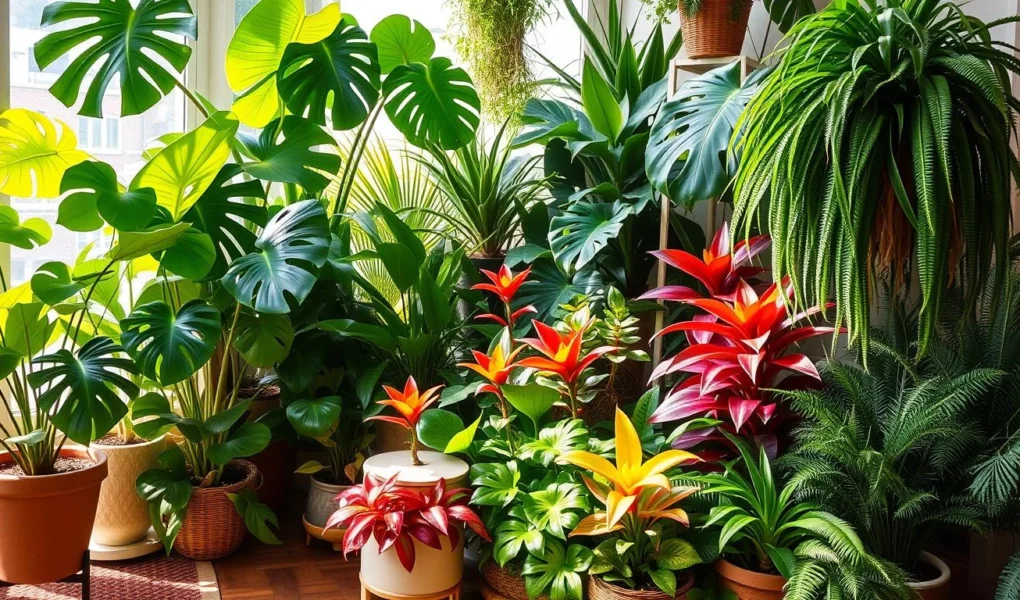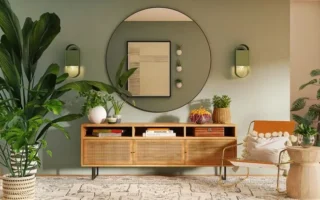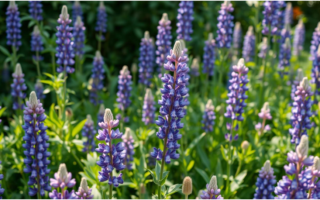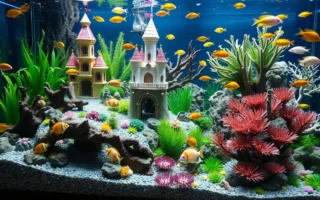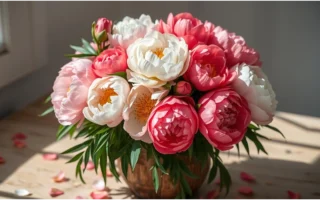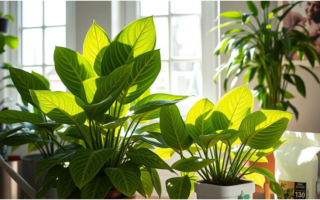Table of Contents
Imagine stepping into a lush oasis, surrounded by vibrant greenery and exotic blooms, without ever leaving your home. This is the magic of tropical house plants. They can turn any room into a stunning indoor paradise. By adding tropical house plants to your space, you can purify the air and enhance the look. You also get a sense of tranquility and connection to nature.
Thank you for reading this post, don't forget to subscribe!Indoor tropical plants bring excitement and beauty to any room. Whether you’re a seasoned plant lover or just starting, you’ll find many benefits. They offer a wide range of possibilities for bringing the tropics indoors.
Key Takeaways
- You can create a stunning indoor oasis with tropical house plants
- Indoor tropical plants can purify the air and enhance the aesthetic of any room
- Tropical house plants come in a wide range of shapes, colors, and textures
- They can add a touch of excitement and beauty to any room
- Bringing the tropics indoors can create a sense of tranquility and connection to nature
- Tropical house plants are a great option for both experienced plant enthusiasts and beginners
Transform Your Home Into a Tropical Paradise
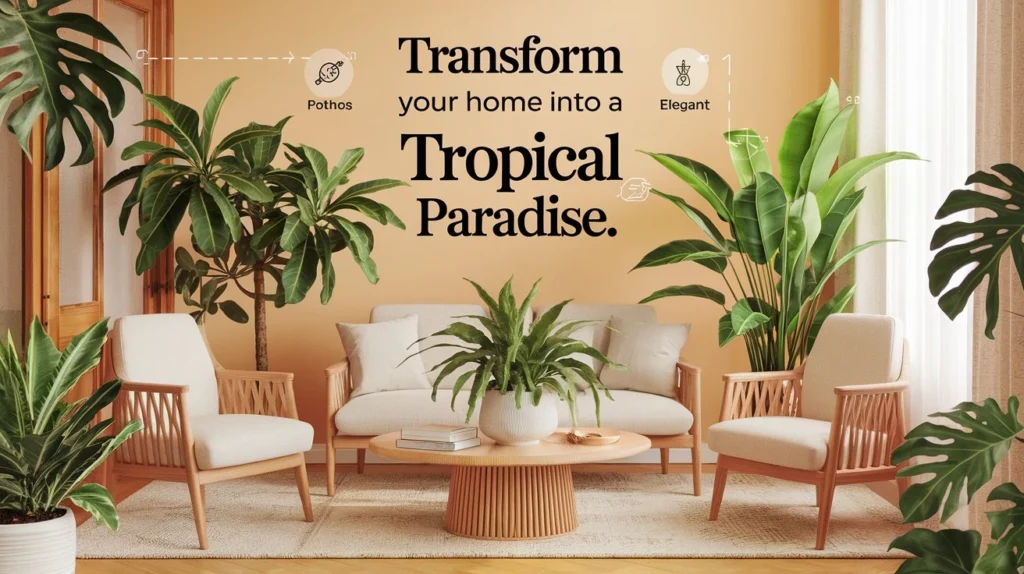
With the right tropical indoor plants, you can make your home a peaceful spot. It’s great for unwinding and having fun. Choose low maintenance tropical plants that are simple to care for and can grow well in different places.
When picking tropical indoor plants, think about how much space you have and how much care you can give. Some easy-to-care-for low maintenance tropical plants include:
- Pothos
- Dracaena
- Philodendron
These plants are not just pretty; they also clean the air and lower stress. Adding them to your decor makes your home feel like a tropical getaway.
To make your space even more tropical, pay attention to the light and temperature. Most tropical indoor plants like bright, indirect light and temperatures between 65-75°F (18-24°C). Knowing this helps you make the best spot for your plants to grow.
| Plant | Lighting | Temperature |
| Pothos | Low-Medium | 65-75°F (18-24°C) |
| Dracaena | Medium-High | 65-75°F (18-24°C) |
| Philodendron | Medium | 65-75°F (18-24°C) |
By following these tips and picking the right tropical indoor plants, you can turn your home into a beautiful tropical paradise. It will bring you happiness and calm.
Essential Tropical House Plants for Beginners
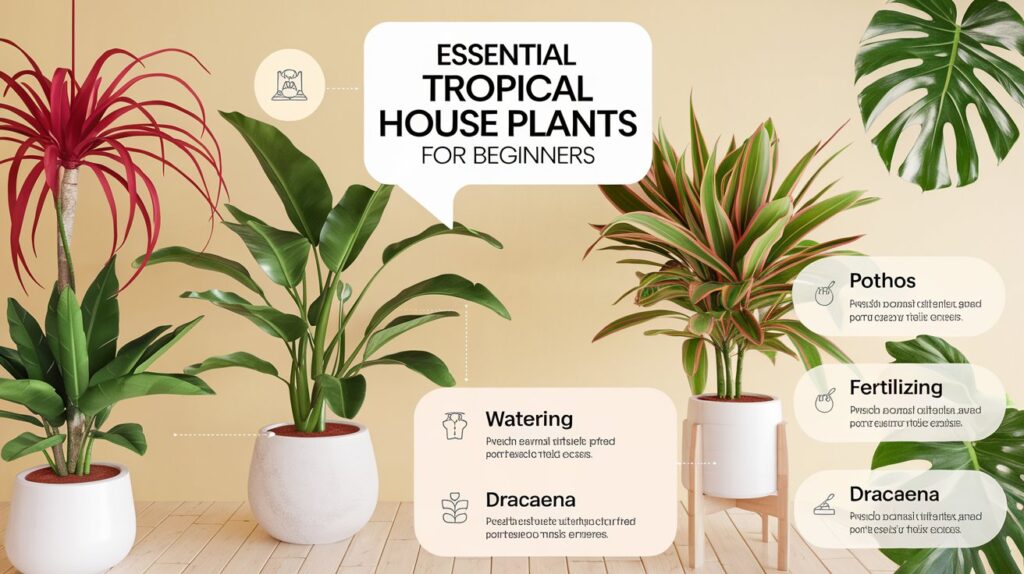
There are many tropical house plants perfect for beginners. They are beautiful and easy to care for. The Spider Plant, Pothos, and Dracaena are some of the most popular.
These plants are forgiving and can thrive in different conditions. They are great for those learning about tropical house plants care. To keep them happy, water them when the soil is dry, fertilize regularly, and prune as needed.
Here are a few tips to get you started:
- Water your plants when the soil feels dry to the touch
- Fertilize your plants during the growing season (spring and summer)
- Prune your plants to maintain their shape and promote new growth
By following these tips and choosing the right plants, you’ll create a beautiful indoor garden. With proper care, you’ll enjoy your plants for years.
Remember, the key to successful tropical house plants care is to start with easy plants. Be patient and observant. With practice, you’ll master even the toughest care tasks.
Light Requirements for Thriving Indoor Tropical Plants
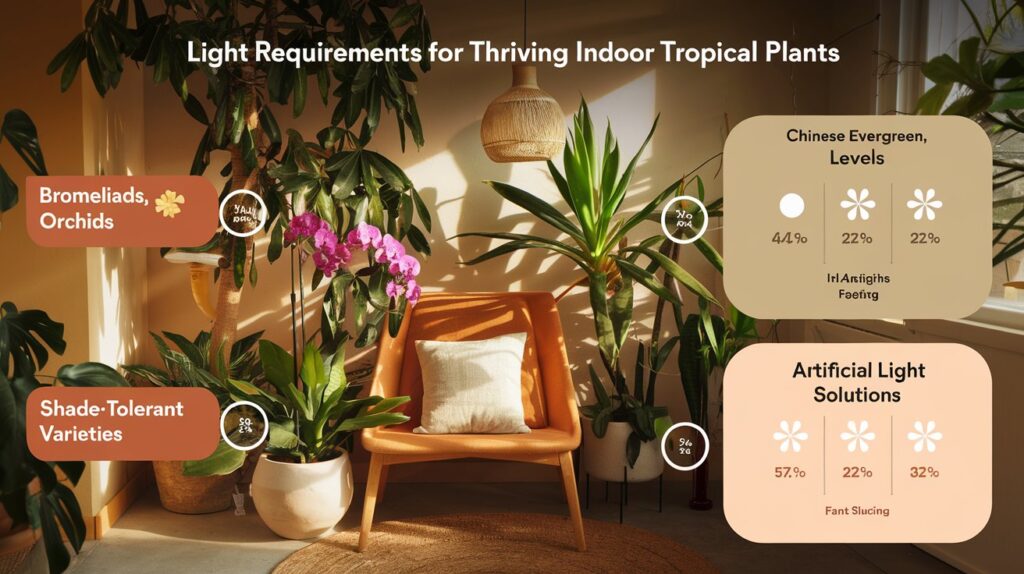
Understanding the light needs of indoor tropical plants is key to their health. Different plants need different amounts of light. Some love direct sunlight, while others prefer shade or artificial light.
To create the best environment for your plants, consider these light needs:
- Direct light lovers: Plants like bromeliads and orchids need direct sunlight to grow and bloom.
- Shade-tolerant varieties: Plants like Chinese evergreen and pothos do well in low light. They’re great for rooms with little natural light.
- Artificial light solutions: If you don’t have a sunny spot, use grow lights. They help provide the light your plants need to thrive.
Knowing your plants’ light needs helps you care for them better. This includes more than just watering and fertilizing. It’s also about giving them the right environment to grow.
With the right lighting, you can make a beautiful indoor tropical oasis. It adds a touch of the exotic to your home. So, research your plants’ light needs and watch them thrive under your care.
| Plant Type | Light Requirement |
| Bromeliads | Direct Sunlight |
| Chinese Evergreen | Low Light |
| Pothos | Low Light |
Mastering Tropical House Plants Care
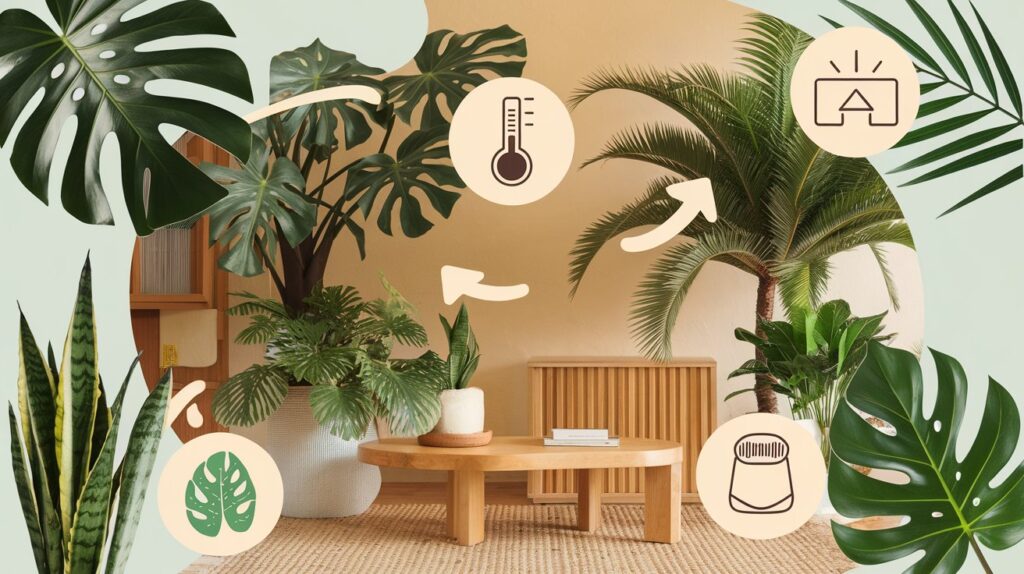
Starting your journey to bring the tropics indoors is exciting. Knowing what your tropical house plants need is key. With a bit of practice, you can learn to care for these plants, even if you’re new or busy. Focus on low maintenance tropical plants that do well indoors.
First, learn the basics like watering, humidity, and fertilizing. Here are some tips:
- Water your plants sparingly, letting the soil dry a bit between waterings
- Keep the air humid, aiming for 40-60% relative humidity
- Fertilize regularly with a balanced fertilizer during the growing season
Follow these tips to create a great home for your tropical house plants. Pick low maintenance tropical plants that match your lifestyle. Don’t hesitate to try new things and learn as you go. With patience and practice, you’ll become a pro at caring for tropical plants.
For beginners, consider plants like the Snake Plant, ZZ Plant, and Pothos. They’re great for beginners because they’re easy to care for and can handle different conditions.
Learning to care for your tropical house plants brings many benefits. It can purify the air and improve your mood. So, why not start today and add a tropical touch to your home?
Humidity and Temperature Control for Indoor Tropicals
Creating a great home for your tropical indoor plants means paying attention to humidity and temperature. These plants need specific conditions to thrive. Start by checking your home’s natural humidity and temperature levels. Then, adjust them as needed.
To keep your plants happy, try these humidity and temperature tips:
- Using a humidifier to increase moisture levels
- Placing plants on a tray filled with water and pebbles to create a microclimate
- Grouping plants together to create a humid microenvironment
Most tropical plants like daytime temperatures between 65-75°F (18-24°C). At night, they prefer it 5-10°F (3-6°C) cooler. By controlling these factors, you can make a perfect home for your plants. This lets them grow well and adds a tropical feel to your space.
By following these tips, you can become a great plant caregiver. Enjoy the beauty and benefits of having these plants in your home.
| Plant Type | Optimal Humidity | Optimal Temperature |
| Tropical Ferns | 50-70% | 65-75°F (18-24°C) |
| Tropical Peace Lilies | 40-60% | 65-80°F (18-27°C) |
Soil and Fertilization Guidelines
For tropical house plants, the right soil and fertilization are key. Finding the best potting mix for your indoor tropical plants can be tough. But, it’s vital to pick a mix that drains well and holds the right moisture.
Here are some tips for fertilizing your tropical house plants:
- Use a balanced fertilizer made for indoor tropical plants.
- Don’t over-fertilize, as it can harm your plants’ roots and leaves.
- Think about using organic fertilizers like compost or manure tea for a natural option.
Repotting is also key for your tropical house plants. You should repot them every 1-2 years. This gives them fresh soil and room to grow in a bigger pot.
By following these guidelines, you can help your indoor tropical plants thrive. They’ll bring a bit of the tropics into your home.
| Plant Type | Soil Requirements | Fertilization Needs |
| Tropical House Plants | Well-draining potting mix | Balanced fertilizer, organic options |
| Indoor Tropical Plants | Moisture-retentive potting mix | Regular fertilization, avoid over-fertilizing |
Common Problems and Solutions for Tropical House Plants
Exploring tropical house plants care can lead to common issues. These problems can harm your plants’ health and beauty. We’ve gathered solutions and tips to help you tackle these challenges.
Knowing the risks is key to caring for tropical house plants. By understanding common problems, you can prevent them. This ensures your plants stay healthy and vibrant.
Pest Management
Pests like spider mites, mealybugs, and scale can damage your plants. Regular checks and isolating infested plants can help manage pests.
Disease Prevention
Diseases can cause problems like yellow leaves and black spots. Preventing disease starts with careful watering. Avoid overwatering to prevent root rot. Fungicides can also help stop disease spread.
Troubleshooting Growth Issues
Slow growth can be due to many reasons. Lack of light, poor watering, and bad soil are common culprits. Check your plant’s environment and make necessary adjustments for better growth.
By following these tips, you can enjoy tropical house plants at home. Stay alert and regularly check your plants for the best care.
| Common Problem | Solution |
| Pests | Inspect plants regularly, isolate infested plants, and use insecticidal soap |
| Diseases | Water carefully, avoid overwatering, and use fungicides |
| Growth Issues | Assess plant environment, adjust lighting, watering, and soil quality as necessary |
Propagation Techniques for Popular Tropical Plants
Exploring tropical indoor plants can be exciting. You might want to share your favorites or grow more. Propagation is a simple way to do this. For easy-to-care plants, you can use division, layering, or start seeds.
Division works well for mature plants like Dracaena and Philodendron. You just separate the roots to make new plants. Layering is good for Pothos and Wandering Jew. You bend a stem down and hold it with a rock or wire.
Starting seeds is another option. Use a seed tray or small pot with a mix that drains well. Plants like Bromeliads and Anthurium grow well from seeds. Here are some tips for success:
- Keep the area warm and humid to help roots grow
- Give plants enough light, but not too much direct sun
- Water carefully to avoid drowning the young plants
With these tips, you can grow your favorite tropical plants. You can share them with friends or add to your collection. Propagation is easy with a bit of patience and practice. Soon, you’ll be an expert at growing low maintenance tropical plants.
| Propagation Method | Plant Species | Success Rate |
| Division | Dracaena, Philodendron | 80-90% |
| Layering | Pothos, Wandering Jew | 70-80% |
| Seed Starting | Bromeliads, Anthurium | 50-70% |
Styling with Tropical Plants: Design Tips and Inspiration
Adding tropical house plants to your home decor opens up endless possibilities. You can group plants, pick the right containers, and use vertical space. This adds elegance and brings a sense of calm and connection to nature.
Think about the style you want for your indoor tropical plants. Do you like modern or bohemian? Use tropical house plants to make a space that shows your personality. Group plants by texture and color for a cohesive look.
Creating Plant Groupings
Grouping plants is an art that needs planning and trying different things. Start by picking plants of different heights, textures, and colors. Good choices include ferns, peace lilies, and bromeliads.
Container Selection
Picking the right containers for your tropical plants is key for a stylish display. Choose containers that match your plants’ colors and textures, like terracotta or wicker. Hanging baskets or wall planters add whimsy.
| Plant | Container | Style |
| Ferns | Terracotta pots | Bohemian |
| Peace lilies | Wicker baskets | Modern |
| Bromeliads | Hanging baskets | Tropical |
With these design tips, you can make a beautiful display with your tropical plants. It will show your style and add elegance to your home.
Ready to Start Your Indoor Tropical Journey
Now that you’ve learned about tropical house plants, it’s time to start your own green journey. Whether you’re new to plants or already a fan, this guide has given you the tools to create a tropical oasis at home.
Begin by visiting your local nursery or checking online plant stores for the perfect tropical plants. With a bit of care, these plants will flourish, turning your space into a peaceful, nature-inspired haven. Welcome the tropical lifestyle and watch your indoor jungle grow, bringing tropical warmth to your home.
FAQ
What are the benefits of having tropical house plants?
Tropical house plants add greenery to your home. They purify the air, reduce stress, and create a calm atmosphere. They can make any room look better and improve your mood.
How do I create the perfect tropical atmosphere in my home?
To get a tropical vibe, think about lighting, temperature, and humidity. Pick plants that love bright, indirect light. Use artificial lights if needed.
Keep the temperature warm (65-85°F). Use humidifiers or pebble trays to add moisture.
What are some of the most popular and low-maintenance tropical house plants?
Popular easy plants include Monstera deliciosa, Pothos, Philodendron, ZZ plant, and Snake plant. They have lush leaves and do well indoors.
What are the different lighting requirements for tropical house plants?
Tropical plants need different lights. Some, like Fiddle-Leaf Fig, need direct sunlight. Others, like Philodendrons, prefer shade.
If your room is dark, use artificial lights to help.
How do I properly care for my tropical house plants?
Caring for tropical plants means knowing their needs. Don’t overwater, as they hate too much moisture. Keep the air humid with humidifiers or group plants.
Fertilize often during the growing season to feed them.
How do I manage pests and diseases on my tropical house plants?
Common problems include pests like spider mites and diseases like root rot. Keep your plants clean, check them often, and use safe pest control.
Act fast to stop problems from spreading.
How can I propagate my tropical house plants?
Propagating plants is a great way to grow more or share. Use stem cuttings, division, or air layering. Follow the right steps for your plant to succeed.
How can I style and incorporate tropical house plants into my home décor?
Tropical plants are great for decorating. Mix plants of different sizes and textures. Choose stylish pots that match your style.
Use vertical space with hanging baskets or stands. This adds a lush feel to your home.

